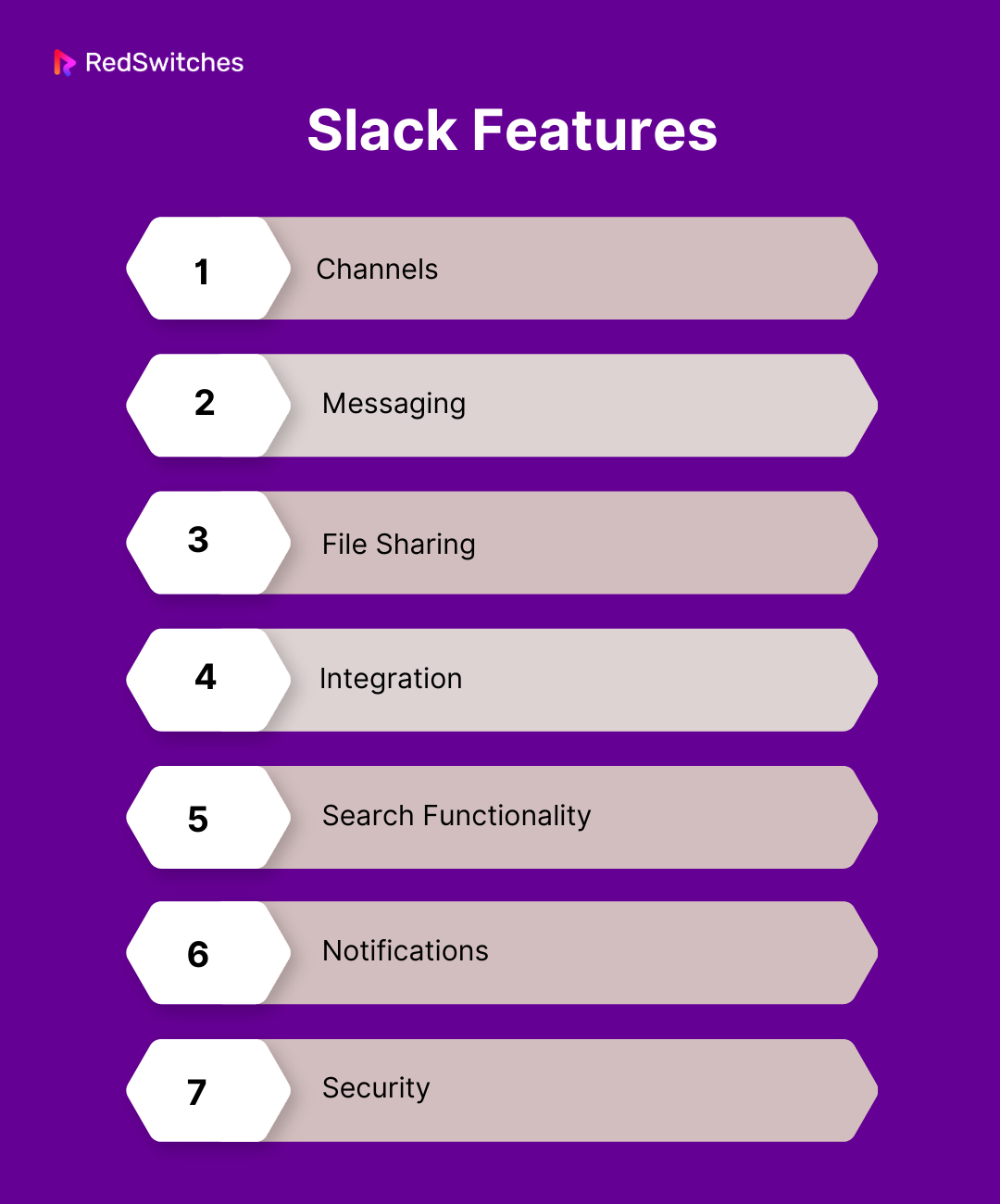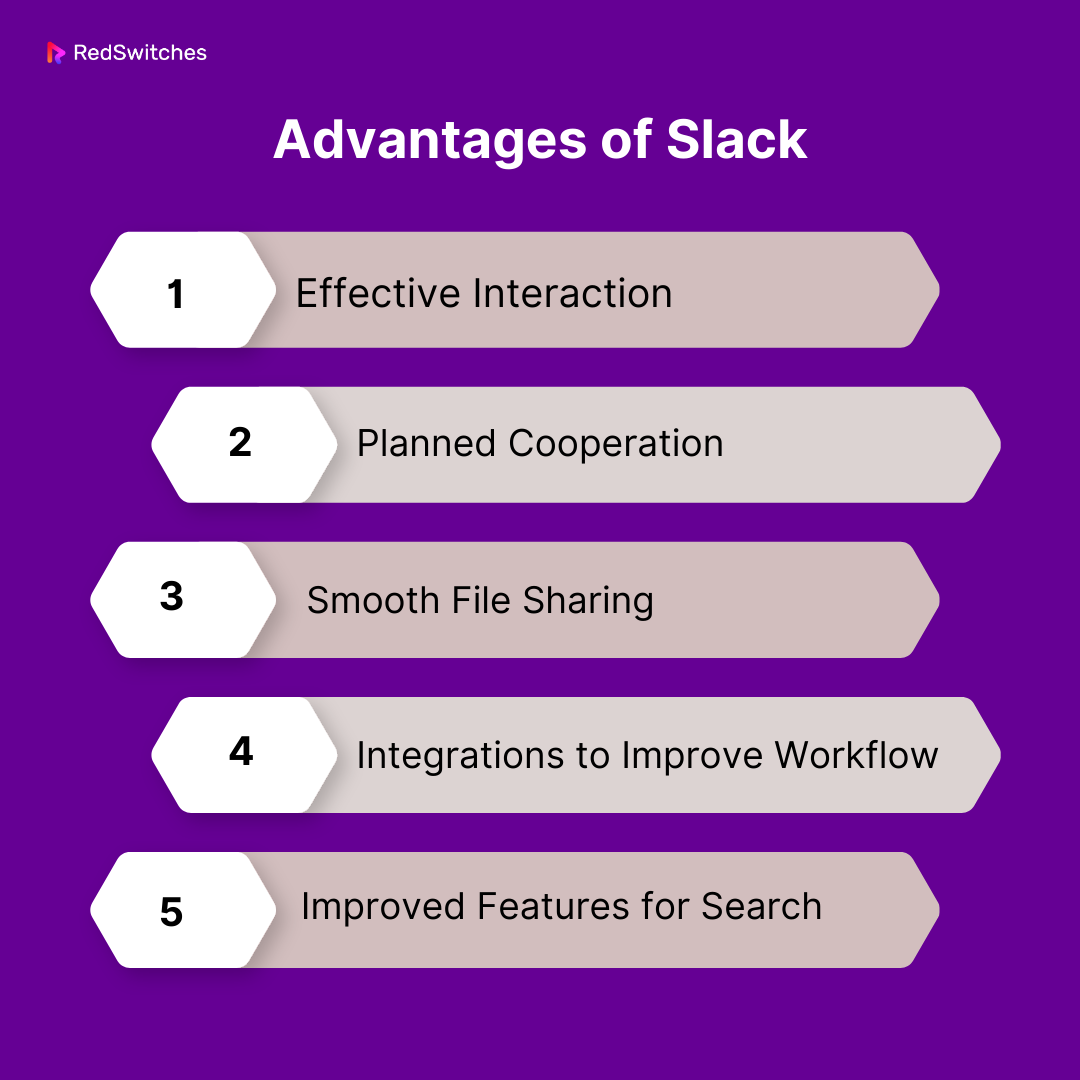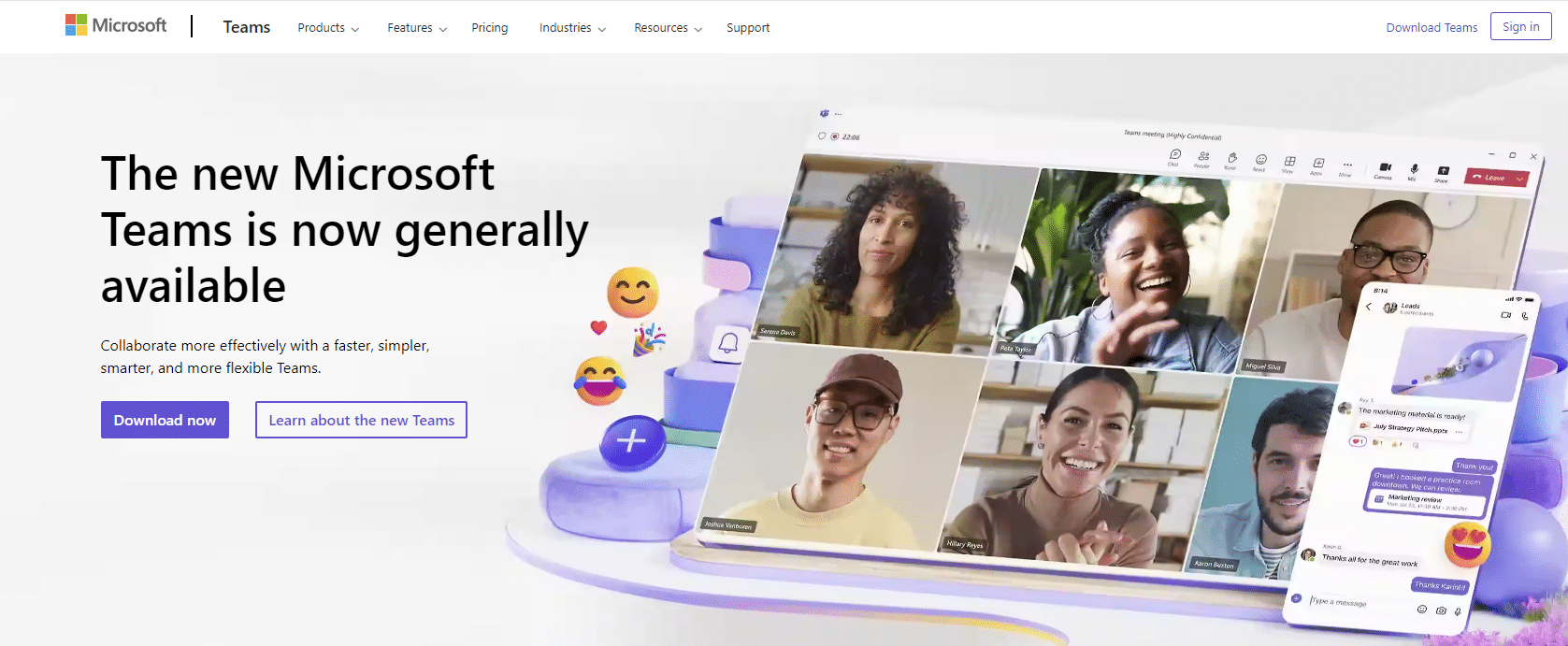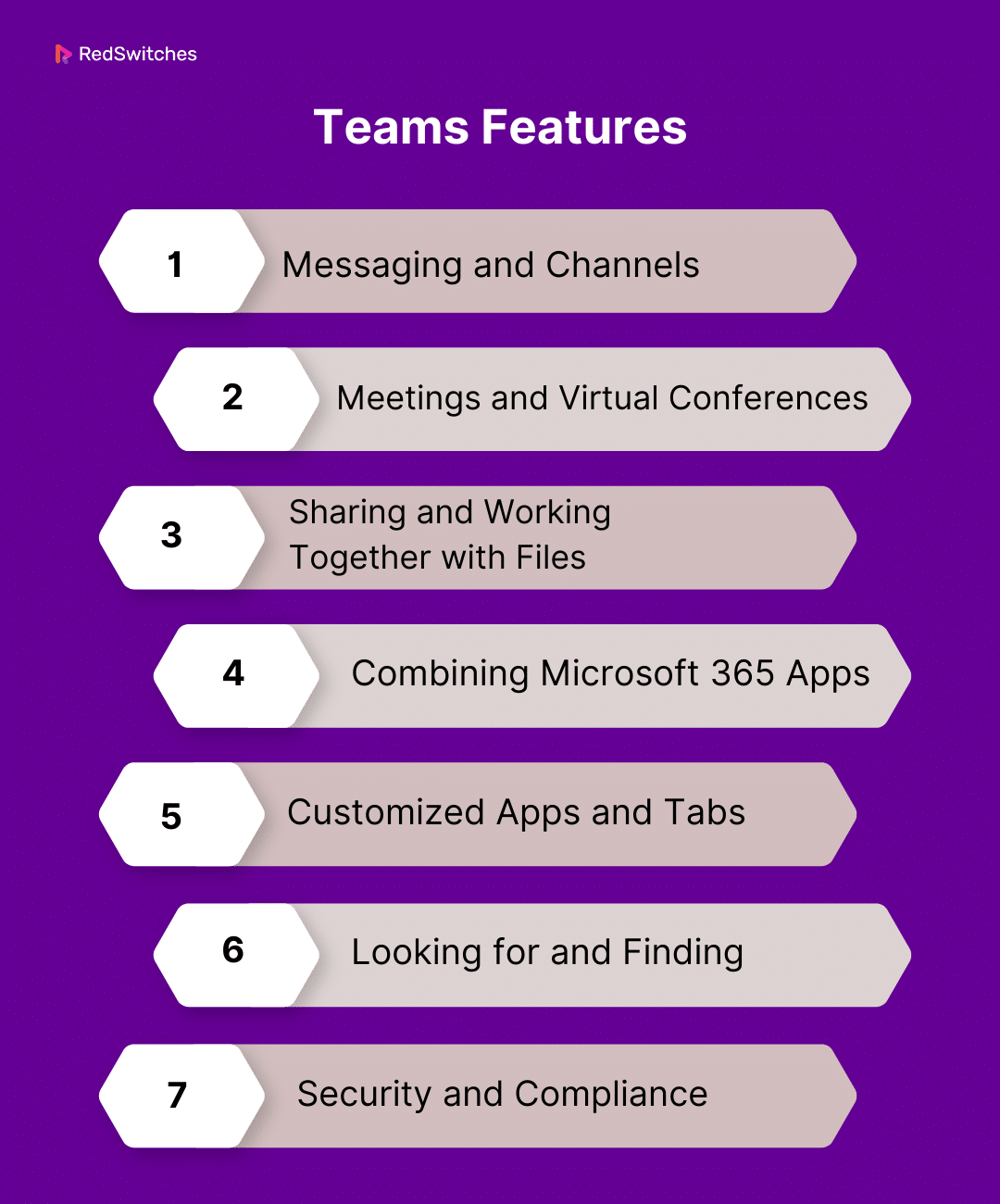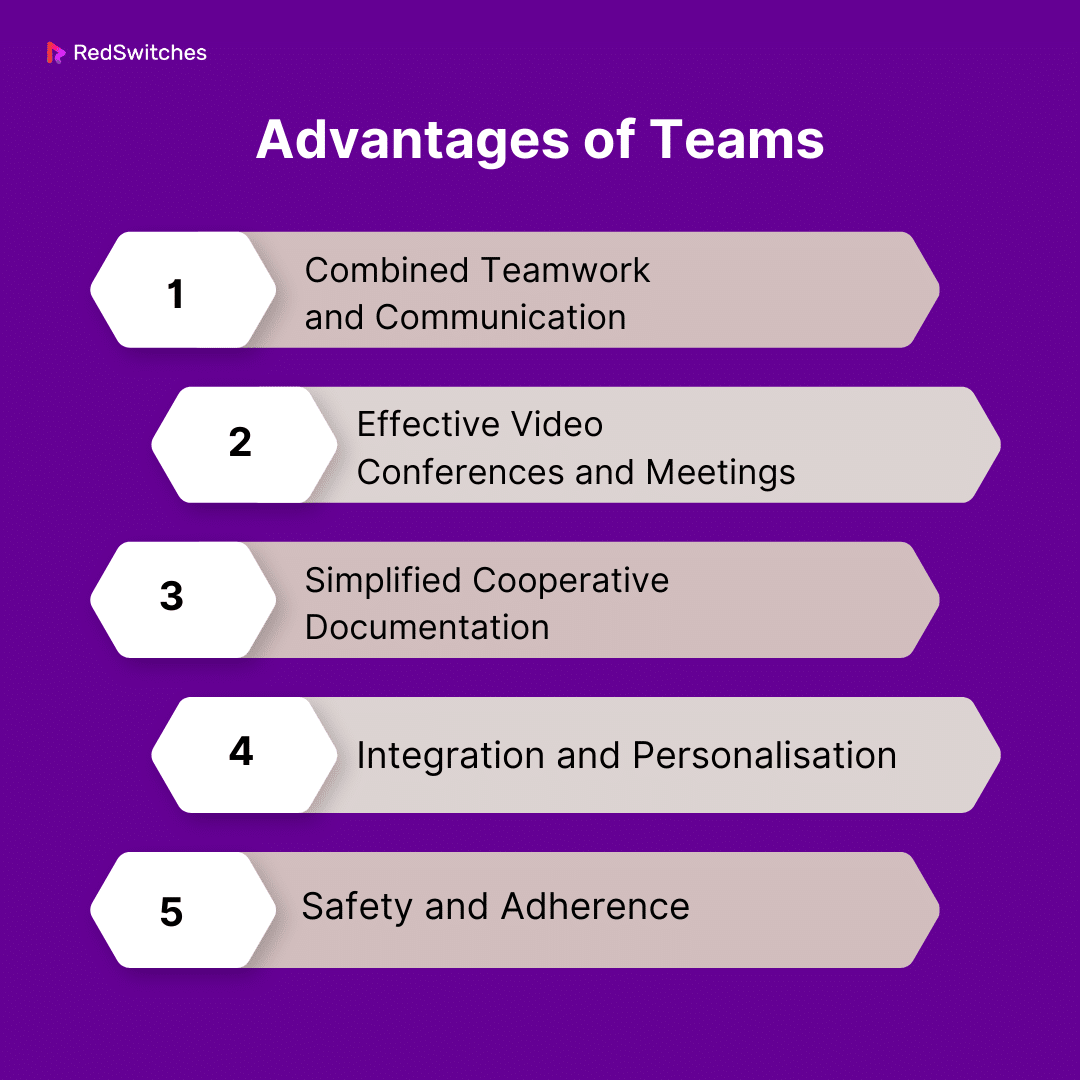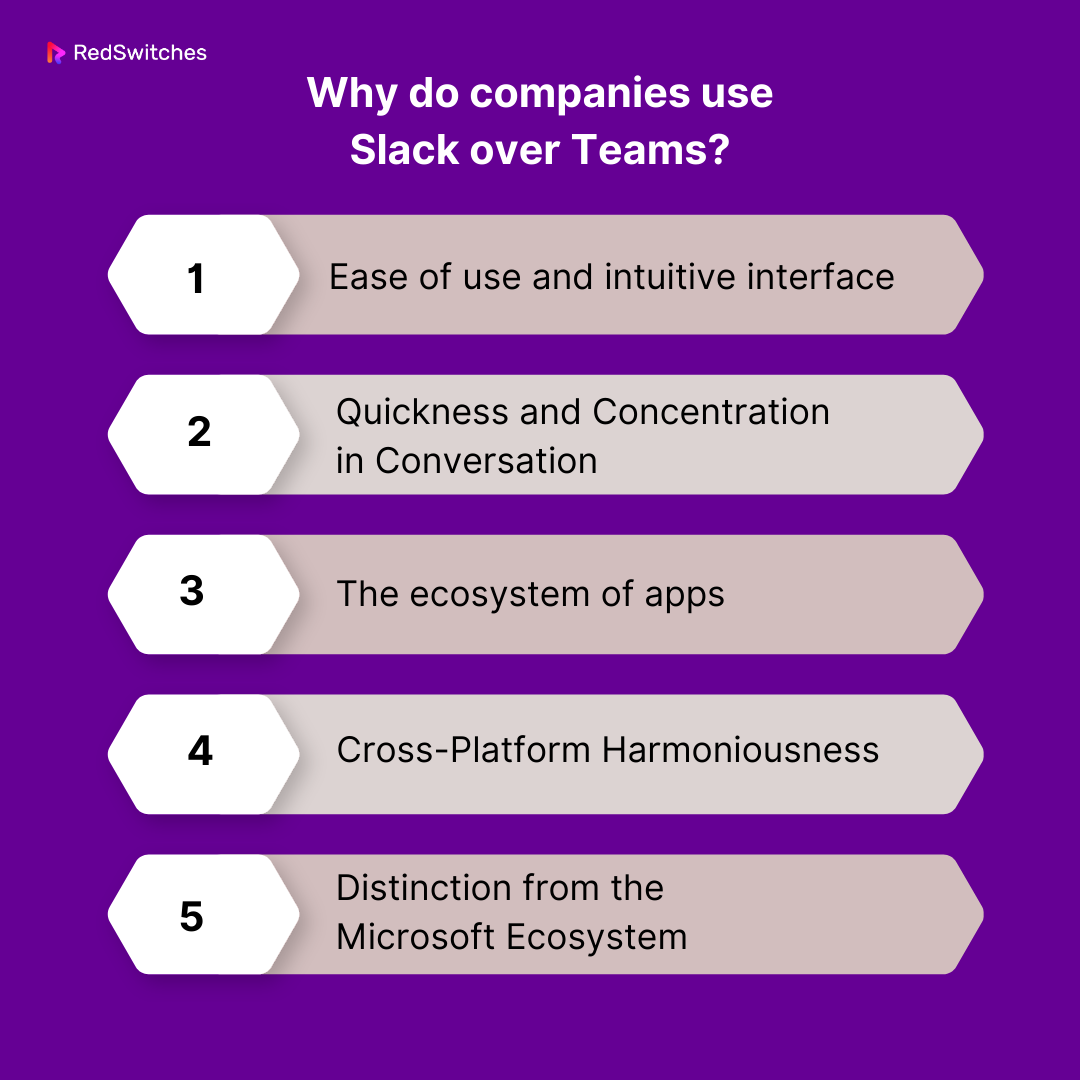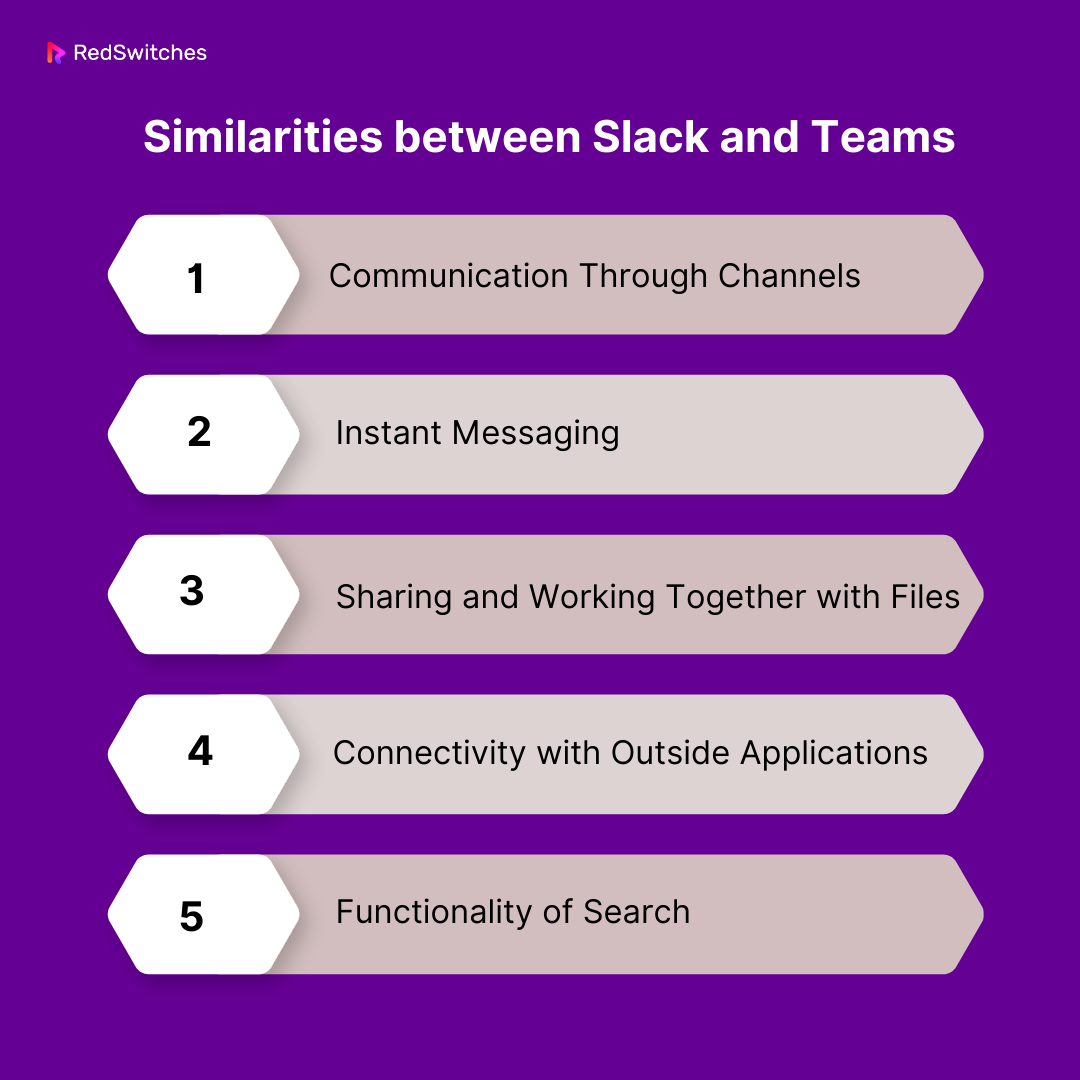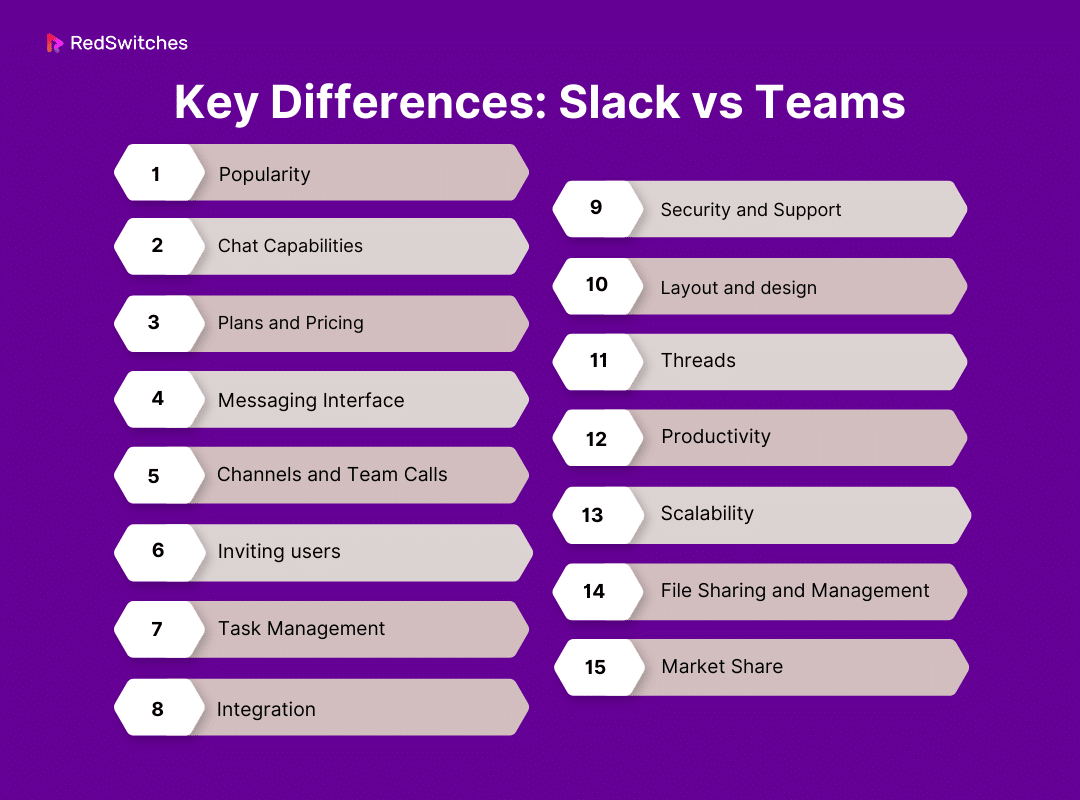Key Takeaways
- Slack offers an intuitive, user-friendly interface ideal for teams prioritizing ease of use and quick communication.
- Slack shines with its vast ecosystem of third-party integrations, making it versatile for teams that rely on a wide range of external tools and services.
- Slack is primarily a messaging and collaboration tool, making it a strong choice for teams whose core needs are real-time communication and file sharing.
- Slack is often preferred by smaller to medium-sized teams due to its straightforward setup and focus on chat-based communication.
- Teams is deeply integrated with Microsoft 365, offering a seamless experience for users of Microsoft’s productivity suite, including real-time collaboration on Office documents.
- Microsoft Teams provides broader collaboration tools beyond messaging, including robust video conferencing and project management features.
- Microsoft Teams offers advanced security features and compliance standards for organizations with strict security and compliance requirements, making it a preferred choice for larger businesses.
Slack and Microsoft Teams are two popular collaboration tools. They help teams talk and work well together. Slack is a chat-based platform that offers a wide range of third-party integrations and a user-friendly interface.
But Microsoft Teams is a full collaboration suite. It offers chat, video calls, and document management. Both tools have strengths and weaknesses. The choice between them depends on the needs of each organization.
In this article, we will look at Slack vs Teams side by side. We’ll uncover 15 critical differences between them. This will help you determine the best fit for your team. You may love organizing things. Or, you may love chatting with your team. Or sharing files without a headache. Understanding these differences will make choosing them easier. So, let’s dive in and explore these two unique tools!
Table Of Contents
- Key Takeaways
- What is Slack?
- What is Microsoft Teams?
- Why Do Companies Use Slack Over Teams?
- Similarities Between Slack and Teams
- Key Differences of Slack vs Teams
- Slack vs Teams: Popularity
- Slack vs Teams: Chat Capabilities
- Slack vs Teams: Plans and Pricing
- Slack vs Teams: Messaging Interface
- Slack vs Teams: Channels and Team Calls
- Slack vs Teams: Inviting Users
- Slack vs Teams: Task Management
- Slack vs Teams: Integration
- Slack vs Teams: Security and Support
- Slack vs Teams: Layout & Design
- Slack vs Teams: Threads
- Slack vs Teams: Productivity
- Slack vs Teams: Scalability
- Slack vs Teams: File Sharing and Management
- Slack vs Teams: Market Share
- Which is Better: Slack or Microsoft Teams?
- Conclusion
- FAQs
What is Slack?
Credits: Freepik
Slack is a messaging app for businesses that connects people to the information they need. Since it started in 2013, Slack has grown in popularity among businesses. This is especially true for those with distributed or remote staff. The platform offers a central location for file sharing, teamwork, and communication.
It helps teams work together as a cohesive unit, transforming how organizations communicate. Slack allows people to work in dedicated spaces called channels. Channels bring together the right people and information. It supports asynchronous work, making it easy for users to access the information they need on their own time.
Additionally, it aims to streamline team interactions and information sharing. It is used for project management, teamwork, and everyday communication. This will increase productivity and promote a more cohesive workplace.
Slack’s primary function is team communication; these add-ons are supplementary. Slack offers two forms of communication: channels (group chat) and direct messages, or DMs (person-to-person chat).
Features of Slack
In this section, we will explore the pivotal features of Slack in depth.
Channels
Slack uses channels to organize teams. Each team can set up channels for projects, departments, or subjects. This design helps focus conversations and cut clutter. This system ensures smooth communication. It also provides better oversight of discussions. It improves efficiency in the workspace.
Teams can make channels for projects, departments, or subjects. This helps targeted conversations. Keeping things organized helps team members find and join important discussions. It also reduces clutter.
Messaging
Slack’s messaging feature makes real-time communication via channels or direct messages possible. This encourages quick and effective teamwork. It lets groups hold lively talks, take fast action, and deal with urgent issues on time. The adaptability of private and public messaging guarantees communication versatility.
File Sharing
Slack’s file-sharing feature makes cooperation easy. Users may easily share papers, photos, and other files within the platform. This feature makes third-party file-sharing programs unnecessary. It gives teams a single place to access, talk about, and work together on shared resources.
Integration
The foundation of Slack’s adaptability is its integration possibilities. Thanks to links with many other apps and services, users can centralize workflows in Slack. This guarantees that teams can use their preferred external tools in Slack. It boosts productivity. Some popular integrations include:
- Google Drive
- Zendesk
- Asana
- GitHub
- Trello
- Salesforce
- Gmail
- Jira
- Pipedrive
- Basecamp
- Google Apps
Search Functionality
Slack’s powerful search feature makes it easier to locate specific information. Users may quickly find past discussions. They can locate specific files and browse large message histories. They can do this with the help of many search options, filters, and modifiers. This improves the platform’s overall information retrieval efficiency.
Notifications
Thanks to Slack’s notification system customization possibilities, users have communication flexibility. Slack makes sure team members know important info. It avoids inundating them with notifications. Users can tailor their preferences for channels, keywords, or mentions. An additional feature that encourages concentrated work periods is the “Do Not Disturb” mode.
Security
Slack places a high premium on security, and the platform takes many precautions to safeguard private data. This also involves data encryption to protect data in transit and at rest. These security features make users feel secure. They keep the information and conversations they share safe. It makes Slack a reliable platform for companies with strict security guidelines.
Here’s our complete guide on web application security 101. It covers what it is, how it works, best practices, & everything in between.
Advantages of Slack
Now let’s understand the advantages of Slack.
Real-time Interaction
Teams may connect instantaneously, thanks to Slack’s facilitation of real-time messaging. It encourages prompt decision-making and responsiveness, which are essential in hectic work settings.
Planned Cooperation
Teams can organize their conversations around particular subjects, tasks, or divisions using Slack’s channel-based organization system. This encourages structure, clears the air, and guarantees pertinent discussions stay on topic.
Smooth File Sharing
Slack’s drag-and-drop feature makes file sharing simple. Team members can easily share papers, photos, and file formats, facilitating teamwork and guaranteeing everyone access to the necessary resources.
Integrations to Improve Workflow
Thanks to its comprehensive App Directory, users may integrate various third-party apps and services with Slack. Because of its adaptability, workflows can be centralized, allowing teams to work more productively by integrating their favorite tools into the Slack environment.
Improved Features for Search
Slack’s robust search feature simplifies locating particular conversations, files, or messages. This makes information easily accessible and is particularly useful in settings with a lot of communication.
What is Microsoft Teams?
Credits: Microsoft
Microsoft Teams is a cloud-based tool for team communication in the Office 365 and Microsoft 365 app suites. Its primary features include file sharing, video conferencing, business messaging, and calling. Companies of any size can use it.
Teams is a business communications program that lets employees work together on projects in real-time or almost real-time on various devices, such as laptops and mobile phones. It is helpful for both local and remote workers.
Slack, Cisco Webex, and Google Workspace are its competitors. Exchange, PowerPoint, SharePoint, and other Microsoft business software are all integrated with Microsoft Teams. It is particularly helpful for remote collaboration because it keeps scattered teams of employees linked and communicating.
Also Read What is Google Cloud?: An In-Depth Look at Google Cloud 2023
Features of Teams
Now, let’s understand the key features of Teams.
Messaging and Channels
Threaded Conversations: Teams may communicate in an organized manner with Microsoft Teams’ threaded conversation technology, which is available within channels. This function ensures that conversations stay structured and targeted to particular subjects or tasks.
Meetings and Virtual Conferences
Integrated Video Conference: Teams has built-in video conferencing features that let users plan and attend meetings from the platform. This feature, which promotes in-person collaboration regardless of physical location, is crucial for distributed or remote teams.
Sharing and Working Together with Files
OneDrive and SharePoint Integration: Microsoft Teams’ seamless integration with OneDrive and SharePoint makes effective file sharing and teamwork possible. Teams can collaborate on projects more efficiently when users can co-author documents in real time.
Combining Microsoft 365 Apps
Collaboration with Office Apps: Word, Excel, and PowerPoint are just a few Microsoft 365 apps that Teams easily interact with. This integration expedites collaboration by enabling users to work on documents immediately within Teams.
Customized Apps and Tabs
Customized workplaces: Teams allow users to create tabs and incorporate outside apps to personalize their workplaces. This flexibility allows teams to centralize their workflows and use critical tools within the Teams interface.
Looking for and Finding
Smart Search: Teams has an extensive search capability that makes it easy for users to locate files, discussions, and messages. This makes it easier for users to find specific content and is especially helpful in surroundings with a lot of information.
Security and Compliance
Enterprise-Level Security: Microsoft Teams prioritizes security by including features like multi-factor authentication, data encryption, and industry-standard compliance. Teams are a safe platform for corporate collaboration because of these safeguards for private data.
Advantages of Teams
After learning the features, we will now focus on the Teams’ advantages.
Combined Teamwork and Communication
Microsoft Teams combine tools for collaboration and communication into one platform. It offers a single area where teams can collaborate easily without using different apps; thanks to capabilities like chat, video conference, file sharing, and collaborative editing.
Effective Video Conferences and Meetings
Teams make setting up and participating in video meetings easier. With its built-in video conferencing features, teams can easily hold virtual meetings, which promotes productive teamwork and communication—especially for scattered or distant teams.
Also, read our comprehensive blog on physical servers vs virtual servers, with 5 key differences explained.
Simplified Cooperative Documentation
Teams easily connect to OneDrive and SharePoint, facilitating productive document collaboration. By ensuring that team members can work together on documents in real time, this integration increases efficiency and does away with the need for third-party file-sharing services.
Integration and Personalization
Microsoft Teams lets users create tabs and integrate third-party apps into configurable workplaces. Because of this adaptability, teams can customize their workspace to meet their unique requirements, streamlining processes and increasing productivity by integrating pertinent tools directly into the Teams interface.
Safety and Adherence
Microsoft Teams prioritizes security by offering enterprise-level features, including multi-factor authentication, data encryption, and industry-standard compliance. Because of its dedication to security, Teams is a reliable platform for companies with strict security guidelines, as it guarantees the preservation of critical data.
Why Do Companies Use Slack Over Teams?
Before moving toward our core topic of debate on Slack vs Teams, There are some genuine reasons companies prefer Slack over Teams.
Ease of Use and Intuitive Interface
Slack is renowned for having an easy-to-use interface. Its uncomplicated design highlights the importance of simplicity in teamwork and communication. This simplified approach is valued by certain organizations, particularly those whose teams place a high value on user-friendliness.
Quickness and Concentration in Conversation
Slack focuses on helping teams communicate and work together, strongly emphasizing its chat features. Some businesses might choose Slack’s agility and focus on real-time communication over Microsoft Teams’ extra features, notably smaller businesses or those with less complicated collaboration needs.
The Ecosystem of Apps
Thanks to Slack’s extensive app ecosystem, users may easily include many external tools and services into the platform. Businesses who appreciate centralizing their tools within the collaboration platform and tailoring their workflows will find this flexibility appealing.
Cross-Platform Harmoniousness
Slack is renowned for working with various devices and platforms. Because of its adaptability, team members can use any device to access and communicate within the platform easily.
Distinction from the Microsoft Ecosystem
Slack can be more enticing to businesses not as involved in the Microsoft environment. It is a desirable choice for businesses searching for a stand-alone collaboration platform since it functions separately from other productivity suites and tools.
Check out our guide on Discord for business and explore how SMEs can leverage it securely in 2024.
Similarities Between Slack and Teams
Before moving into the Slack vs Teams debate, we will learn their similarities.
Communication Through Channels
Teams and Slack use channels to organize conversations. Different teams can establish project-specific threads or topics on channels, which are dedicated discussion areas to facilitate more efficient communication.
Instant Messaging
Real-time texting is available on both platforms. Instant chatting or direct messaging within channels allows users to communicate quickly and effectively with one another as a team.
Sharing and Working Together with Files
Teams and Slack offer easy file sharing and teamwork tools. Within the site, users can upload and share a variety of file kinds, including documents and photographs. This encourages teamwork when using shared resources.
Connectivity with Outside Applications
Both platforms support integrations with third-party services and apps. This feature allows users to integrate external tools into the collaborative space, increasing output and establishing a single workflow point.
Search Functionality
Teams and Slack both have powerful search features. The platform’s enormous communication history may be easily searched for by users, making it easy to recover certain messages, files, or discussions.
Here’s an article covering the differences between a shared server vs dedicated server.
Key Differences of Slack vs Teams
Now, we will move toward the core topic of our blog, which will help you understand the long-lasting debate of Slack vs Teams with crucial distinctions between them.
Slack vs Teams: Popularity
Let us compare the Slack vs Teams argument concerning the popularity parameter.
Slack
Especially among startups and smaller businesses, Slack quickly became well-known and a significant force in the collaboration platform market. Its quick adoption was facilitated by its extensive range of integrations, real-time communication focus, and user-friendly design.
Thanks to its simplicity and agility, Slack gained popularity among users and became a top option in tech-related and creative businesses. But Slack has had more competition recently, particularly with the emergence of Microsoft Teams.
Teams
Microsoft Teams has experienced significant growth, particularly among larger businesses and organizations already using the Microsoft 365 suite. OneDrive, SharePoint, and Office programs all integrate with it seamlessly, which has greatly aided in its growth.
The larger Microsoft ecosystem has greatly aided teams’ popularity since it offers customers a consistent experience across various productivity products. Its broad usage is partly a result of Microsoft’s strategy of bundling Teams with its Microsoft 365 subscriptions.
Slack vs Teams: Chat Capabilities
Whose chat capabilities are better? Let us compare the Slack vs Teams debate concerning the chat capabilities parameter.
Slack
Slack has become well-known for its comprehensive chat features based on real-time messaging and an easy-to-use UI. The channels on the site allow for structured conversations and provide areas specifically designated for different subjects or projects. Threaded discussions are Slack’s strong suit; they let users respond to individual messages and keep channels organized.
Users can improve how their messages are presented by adding hyperlinks, bullet points, and bold text using rich text formatting. Using the “@” symbol in mentions and alerts ensures that the right team members are informed about particular messages immediately.
Teams
Microsoft Teams is a competitor with an extensive feature set of chat functions that appeal to a broad user base, especially in larger businesses. A key component is real-time messaging, and Teams uses a channel-based organizational structure akin to Slack. Communication in Teams becomes more straightforward with threaded conversations that help preserve context within channels.
Users can format messages for better presentation using rich text formatting tools. Mentioning and notifications (shown by the “@” symbol) ensure that the right people are informed immediately. Teams’ emoji reactions provide the chat experience with more expressiveness.
Slack vs Teams: Plans and Pricing
This section will compare the price parameter in the Slack vs Teams debate.
Slack
Free, Pro, Business+, and Enterprise are four types of Slack plans. Remember, choosing the annual billing plan gives you discounts, while opting for monthly payments will mean higher prices.
Slack offers an Enterprise plan for extensive communication, which may accommodate up to 500,000 users. Businesses that want customizable policies and centralized controls may find this plan especially suitable. To get an idea of the cost, users must contact Slack’s sales staff.
Teams
Let’s now examine the four plans that Microsoft Teams provides:
Available on Microsoft Teams are both premium and free plans. Microsoft Teams offers a more significant participant cap for online meetings, starting at $4.00/month per user.
Slack vs Teams: Messaging Interface
We will now understand how the interfaces differ in our Slack vs Teams debate.
Slack
Slack’s messaging interface is renowned for its ease of use and simplicity. The platform strongly emphasizes direct messages and channels for real-time communication. Messages are arranged in a chat-like style in channels, and threaded conversations are accessible for more in-depth discussions. Thanks to the interface’s simple design, users may easily navigate conversations, reply to messages, and participate in lively discussions.
The expressiveness of messages is increased by rich text formatting choices, including emoticons and file attachments.
Teams
Microsoft Teams offers a feature-rich communications experience integrated into the larger Microsoft 365 ecosystem. Threaded chats within channels are part of the unified experience that the interface is supposed to provide. Because the platform allows rich text formatting, users can highlight essential details in their messages.
Users can easily schedule meetings directly through the interface, share files, and collaborate on documents and texts in real-time.
Slack vs Teams: Channels and Team Calls
Which is more accessible for channels and Team calls? Let’s understand Slack vs Teams concerning this parameter.
Slack
At the heart of teamwork in Slack is its channel-based system, where groups can chat in real-time, share files, and use various integrations, all in specific, organized spaces. Slack offers a structured and dynamic environment, whether for open talks in public channels or more private conversations in private channels.
Although Slack allows team calls, its messaging-centric strategy makes it compelling; calls supplement the main emphasis on asynchronous communication.
Teams
Microsoft Teams uses a channel-based organizational structure, setting aside specific areas for targeted conversations inside teams. Channels are a primary center for all-encompassing collaboration by integrating smoothly with Microsoft 365 services. Teams’ channels facilitate unified collaboration through text messaging, file sharing, and threaded discussions, among other conversational features. With extensive audio and video calling capabilities built into the platform, Teams shines at group conversations.
Slack vs Teams: Inviting Users
Let’s understand Slack vs Teams concerning the parameter Inviting Users.
Slack
Inviting users to Slack is simple and can be handled by workspace managers or members with the necessary access. Administrators can enter the email addresses of new team members to invite them after creating a workspace. After that, email invites from Slack with details on accessing the workplace are sent out.
When recipients click the provided link, the Slack platform is opened, and they can follow the instructions to register for an account and join the designated workspace.
Teams
In Microsoft Teams, adding members to a team is a flexible process that gives administrators or team owners more authority. Members can be added directly within Teams by entering their email addresses after the team is created. As an alternative, users can be added through the company’s directory. Invited individuals can join the team by receiving notifications through email or within Teams. Users can join the team and participate in discussions by clicking the link.
Slack vs Teams: Task Management
We will now understand how the Task Management differ in our Slack vs Teams debate.
Slack
Teams may easily include Slack’s efficient task management tools in their collaborative workflow. Users can use the built-in reminders feature within the Slack UI to establish and get notifications for critical activities. The platform also easily interacts with third-party task management applications like Trello or Asana, enabling teams to centralize information about tasks and discussions.
Teams
Microsoft Teams facilitate efficient task management. It integrates seamlessly with various task management tools. Users can easily assign, track, and manage tasks within their teams. The platform supports collaboration, making it simple to discuss tasks in real-time.
Additionally, Teams offers features like task lists, deadlines, and status updates. This ensures that everyone is on the same page, enhancing productivity. Through its user-friendly interface, managing tasks becomes a streamlined process. Teams’ flexibility accommodates different workflows, catering to diverse team needs.
Slack vs Teams: Integration
Let us understand the Slack vs Teams debate concerning their integration.
Slack
Slack is famous for its many outside apps and services that smoothly fit into the platform. You can see how well it works with them. Users can discover and install integrations customized to their team’s needs through the Slack App Directory, which acts as a central center. By directly integrating additional capabilities into the Slack workspace, Slack’s integration ecosystem improves cooperation across communication apps like Zoom and Google Meet and project management tools like Asana and Trello.
Teams
Integration is where Microsoft Teams shines, especially regarding the larger Microsoft 365 ecosystem. Microsoft Planner, OneDrive, SharePoint, and other Microsoft apps are just a few programs Teams easily interface with. Thanks to this close connectivity, users may access, exchange, and work together on files directly within the Teams interface.
Teams allow users to connect their preferred tools and services by supporting a wide range of third-party connectors in addition to Microsoft 365.
Slack vs Teams: Security and Support
Now, Let us understand the Slack vs Teams debate concerning their Security and Support.
Slack
Slack prioritizes security protocols to protect user information and conversations. Sensitive data is protected by the platform’s data encryption, both in transit and at rest. Additional security capabilities, like Enterprise Key Management (EKM) for more control over data access, are available to enterprise customers. Because Slack complies with numerous industry standards and laws, businesses can be sure that their data is handled securely. Slack provides tools like two-factor authentication (2FA) to improve user account security further.
Teams
Microsoft Teams puts security first by offering many tools to safeguard user information and conversations. The platform ensures secure communication routes by utilizing encryption for both data in transit and at rest. To improve user account security, multi-factor authentication (MFA) is offered. Teams offer a secure environment for organizations by adhering to several industry standards and regulations. Microsoft prioritizes security throughout the whole suite, which includes Teams, and the platform gains from Microsoft 365’s robust security framework.
Slack vs Teams: Layout & Design
We will now understand how the Layout & Design differ in our Slack vs Teams debate.
Slack
Slack is an easy-to-use interface intended to improve communication and teamwork.
The platform is divided into channels, each devoted to a particular subject, group of people, or project. The chat-like presentation of conversations within channels facilitates real-time communication. Quick access to channels, direct messages, and connected apps is available via Slack’s sidebar.
The design of Slack is centered on efficiency and clarity. With messages displayed in an easy-to-read format, the minimalist UI ensures that conversations take center stage.
Teams
Microsoft Teams’ organizational structure is reflected in its layout, which is focused on teams and channels. Teams act as broad containers for several departments or projects, and channels inside teams allow for more focused conversations. Using the left sidebar, you may navigate between teams, channels, and other important features.
The way Teams’ design integrates with Microsoft’s unified design language makes it unique. Users familiar with the ecosystem will find the platform consistent with existing Microsoft 365 applications.
Slack vs Teams: Threads
Now we will understand how the Threads features differ in our Slack vs Teams debate.
Slack
The threaded chat feature in Slack gives users an interactive way to participate in conversations within channels. Users can start threaded conversations in response to specific messages; these conversations are nested discussions below the original message. Through threading, users can explore particular subjects without interfering with the main discussion, which helps crowded channels stay organized and contextual.
Team members can work together more productively and keep talks focused and easy to follow through threaded discussions.
Teams
For improved channel communication, Microsoft Teams also supports threaded conversations. Individual messages can be directly replied to by users, starting threaded discussions that offer a logical and well-organized picture of interactions. Teams’ threaded conversations, which allow users to participate in side conversations without interfering with the main flow of communication, work similarly to Slack in preventing information overload in congested channels.
Slack vs Teams: Productivity
Let us discuss the Slack vs Teams debate concerning their Productivity
Slack
Slack’s wide app integrations, real-time chat, and collaboration tools all contribute to increased productivity. The platform’s direct messages and channels make it easier to communicate quickly and effectively, decreasing the need for drawn-out email threads.
Thanks to the threaded chat feature, users can have targeted talks without overcrowding the main channel, which keeps debates organized. Users can streamline workflow by bringing other tools into the Slack workspace thanks to Slack’s interoperability with other apps and services.
Teams
Microsoft Teams integrates well with the larger Microsoft 365 suite, emphasizing productivity. The platform’s collaborative features, like direct messages and channels, facilitate effective team communication.
Integrating Teams with programs such as Planner, OneNote, and SharePoint offers a complete solution for task organization, note-taking, and document management. Facilitating the scheduling and conduct of meetings inside Teams improves real-time communication.
Slack vs Teams: Scalability
This section will explain the scalability parameter in the Slack vs Teams debate.
Slack
Scalability is a feature that Slack gives to meet the demands of various teams and organizations. The platform offers various plans with a tier-based pricing structure, starting from the free version for small teams and ending with the Enterprise Grid plan for larger organizations. Teams can begin with a basic subscription and scale up as their user base and collaboration needs increase, thanks to Slack’s flexibility.
Specifically tailored for large organizations, the Enterprise Grid plan offers enormous user numbers across many workspaces, advanced security measures, and customization choices.
Teams
Microsoft Teams is made to grow with the demands of different-sized businesses. Teams offer scalability within a comprehensive productivity environment by easily integrating with other Microsoft products as part of the Microsoft 365 package. The team’s scalability is demonstrated by its capacity to accommodate small and large teams.
With Microsoft’s subscription options designed to meet the demands of various organizational sizes, Teams can grow with its user base while providing cutting-edge features, security, and collaborative capabilities.
Slack vs Teams: File Sharing and Management
This section will explain the File Sharing and Management parameter in the Slack vs Teams debate.
Slack
Within its platform, Slack makes effective file sharing possible. Documents, photos, and videos are just a few of the material kinds that users can upload and share straight into channels or via direct messaging. Drag-and-drop functionality is also supported by the platform, making file uploads simple. The Slack interface makes shared files viewable, downloadable, and commentable for team members.
Teams
Robust file-sharing features are provided by Microsoft Teams, which integrates with Microsoft 365 apps with ease. Users can upload, share, and work together on files within Teams channels. The platform makes collaborative document editing easier by enabling real-time co-authoring for Microsoft Office documents. OneDrive or SharePoint house shared files in Teams, guaranteeing a smooth connection with Microsoft’s file storage solutions.
Slack vs Teams: Market Share
Slack and Microsoft Teams are used more frequently in small, medium, and big businesses. As of 2022, Microsoft Teams has 270 million users, more than Slack’s 18 million active users, making it the most widely used platform for business collaboration.
A research study was carried out to compare Slack and Teams’ feature-level engagement. The outcomes were noteworthy:
Private communications: Over 30 days, 89% of active Slack users engaged with private messages, compared to 60% for Teams.
Group messaging: During 30 days, 92% of active Slack users and 11% of active Teams users utilized the group messaging capability.
Attendance in meetings: Of engaged Slack users, only 13% attended a meeting over 30 days, compared to 62% of engaged Teams.
After discussing the key differences in the Slack vs Teams debate, we will learn when to choose what.
Choose Slack If:
Simple Operation and User Experience
Slack is renowned for having an easy-to-use interface. It might be a better option if your team prioritizes an easy-to-use interface.
Integrated Ecosystem
Slack boasts a large ecosystem of third-party app and service integrations. It may be the best choice if a significant portion of your workflow depends on particular products that operate well with Slack.
Message-Based Priority
Slack prioritizes communication and was developed as a tool for chat and teamwork. It might be a better option if the main purposes of the service your team uses are file sharing and real-time messaging.
Small to Medium-sized Teams
Slack is frequently thought to be more suited for smaller teams. It could be a more straightforward option if your company is smaller and doesn’t need the sophisticated communication tools that Microsoft Teams provides.
Choose Teams If:
Connectivity with Microsoft 365
If your company uses Office 365 (formerly Microsoft 365), Microsoft Teams can be easily integrated with Word, Excel, PowerPoint, and SharePoint. This may result in a more seamless user experience.
Working Together Without Messages
Microsoft Teams offers a comprehensive hub for collaboration rather than just a chat service. It provides integrated project management tools, video conferencing, and file sharing. Teams might be better if your group needs a more feature-rich collaboration solution.
Enterprise-grade Compliance and Security
Organizations with stringent security and regulatory requirements prefer Microsoft Teams because of its superior security features and compliance standards. Teams might be a safer choice if your industry requires high security.
Big Businesses and Difficult Projects
Teams are made to grow alongside larger companies with more complicated collaboration requirements. Teams can offer a more complete solution if your team needs substantial project management, document sharing, and a centralized center for numerous tasks.
Conclusion
The Slack vs Teams argument comes down to each company’s requirements and preferences. While Teams offers a comprehensive solution firmly integrated into the Microsoft 365 suite, Slack excels in simplicity and has a vast integration ecosystem. Both platforms offer sophisticated communication and collaboration functions.
Comprehending the 15 principal distinctions we have examined, ranging from subtleties in communication to cooperative features, enables groups to make knowledgeable choices.
When making this decision, keep in mind RedSwitches infrastructure and support. Their dedicated hosting options might be a smooth addition to your chosen platform, guaranteeing a dependable and safe setting for Teams or Slack.
FAQs
Q. Is Slack better than Teams?
It depends on your priorities. Slack has an easy interface and many app integrations. Teams excels at offering a complete collaboration hub. It’s integrated with Microsoft 365.
Q. Which is cheaper, Teams or Slack?
Pricing varies based on features and user needs. Slack may be cheap for small teams. Microsoft Teams could offer more value for organizations already using Microsoft 365.
Q. Why is Slack more popular than Teams?
Slack gained popularity earlier, focusing on messaging and third-party integrations. Teams has closed the gap. It does this by providing a complete collaboration platform. It is deeply integrated with Microsoft’s suite. The choice depends on the context.
Q. Is Slack better than Zoom?
Slack and Zoom serve different purposes. Slack is a messaging and collaboration platform, while Zoom is primarily a video conferencing tool. The choice depends on your team’s specific communication and collaboration requirements.
Q. What is the difference between Slack and Microsoft Teams?
Slack focuses on messaging and collaboration. Microsoft Teams integrates well with other Microsoft Office 365 tools. This makes it a more comprehensive business solution.
Q. How do Slack users benefit compared to Microsoft Teams users?
Slack users enjoy a more streamlined and intuitive interface, making it easier for small teams or personal projects. On the other hand, Microsoft Teams users benefit from integration with other Microsoft 365 business tools.
Q. Which collaboration platform is better, Microsoft Teams or Slack?
The choice between Microsoft Teams and Slack depends on your team’s specific needs. Microsoft Teams offers an all-in-one solution for businesses using Microsoft tools. Slack is a user-friendly option for simpler communication and collaboration.
Q. How does the Slack app compare to Microsoft Teams’ features?
The Slack app is known for its simplicity and ease of use, perfect for quick messaging and file sharing. Microsoft Teams offers more features. These include video calls, Office 365 integration, and project tools.
Q. Can Slack integrate with other tools like Microsoft Teams does?
Slack can integrate with third-party tools. But, Microsoft Teams’ seamless integration with other Microsoft Office 365 apps gives it an edge. This is in terms of collaboration and productivity.
Q. What are some key differences between Slack and Microsoft Teams desktop apps?
Slack and Teams offer desktop apps for better use. But, Teams’ app has more features. It has things like calendar integration. It also has document collaboration and direct access to Microsoft Office apps.
Q. How do new users typically find the experience of using Microsoft Teams or Slack?
New users often find Slack easy to use. It is intuitive, especially for smaller or less tech-savvy teams. On the other hand, Microsoft Teams may require a bit more training but offers a more robust set of features for larger organizations.


